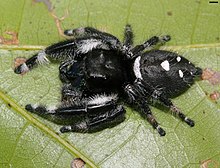Phidippus regius
| Phidippus regius | |
|---|---|

| |
| Orange form adult femaleP. regiusphotographed inOrange County, Florida | |

| |
| Adult maleP. regiusphotographed inNassau County, Florida | |
| Scientific classification | |
| Domain: | Eukaryota |
| Kingdom: | Animalia |
| Phylum: | Arthropoda |
| Subphylum: | Chelicerata |
| Class: | Arachnida |
| Order: | Araneae |
| Infraorder: | Araneomorphae |
| Family: | Salticidae |
| Subfamily: | Salticinae |
| Genus: | Phidippus |
| Species: | P. regius
|
| Binomial name | |
| Phidippus regius C.L.Koch,1846
| |
| Synonyms[1] | |
| |
Phidippus regius,commonly known as theregal jumper,[2]is a species ofjumping spiderfound in parts of the United States and theCaribbean.[1]It is the largest species of jumping spider in eastern North America.[3]
Description
[edit]Adult maleP. regiusmeasure 12 mm (0.47 in) long on average, but can range between 6–18 mm (0.24–0.71 in) long. The first pair of legs, which are disproportionately larger in large males, have an alternating black and white fringe. Theopisthosomais black with several white markings on thedorsum- a basal band, a central triangular spot, and two posterior oval spots. Thecheliceraeare large andiridescentgreen-blue-violet in color, with atubercleon each.[1][3]
Adult femaleP. regiusmeasure 15 mm (0.59 in) long on average, but can range between 7–22 mm (0.28–0.87 in) long. They may exhibit white or orange markings on the opisthosoma similar to the white markings seen in males, but the rest of the body is largely covered with scales which may be brown, orange, tan, gray, or a combination of those colors. The chelicerae are iridescent green or red-violet in color, but lack the tubercles found on the chelicerae of males. Females have several tufts ofsetaearound the eyes that males lack.[1][3]
In southern populations, juvenile females may develop scales as early as the thirdinstar,while males are black and white throughout their life cycle.[3]
Habitat
[edit]P. regiusis most commonly found in relatively open areas, such as fields and light woodland, with adults usually preferring trees or the walls of buildings as hunting grounds. They build silken nests at night in which to sleep, often in palm fronds or similar areas. Females of the species lay their eggs under the bark of trees, or in secluded spots in wooden structures such as barns.[4]
Distribution
[edit]P. regiusoccurs in the southeasternUnited States,Bahamas,Bermuda,Greater Antilles,and has been introduced toEaster Island.In the United States, it occurs throughout the Southeast from SouthMississippithroughNorth CarolinaandSouth Carolina(most abundant inFlorida).[1]
References
[edit]- ^abcdeEdwards, G.B. (2004)."Revision of the jumping spiders of the genusPhidippus(Araneae: Salticidae) "(PDF).Occasional Papers of the Florida State Collection of Arthropods.11.Florida Department of Agriculture and Consumer Services:54–55.Archived(PDF)from the original on 2023-01-17.Retrieved2024-02-01– viaResearchGate.
- ^Breene, R. G."Common Names Of Arachnids 2003 Fifth Edition"(PDF).American Arachnological Society p. 16.Archived(PDF)from the original on 21 March 2023.Retrieved27 March2023.
- ^abcdEdwards, G.B. (2021)."Regal jumping spider -Phidippus regiusC.L. Koch ".Featured Creatures.University of Florida.Archivedfrom the original on 1 February 2024.Retrieved1 February2024.
- ^Almodóvar Rivera, José R.; Mari Mutt, José A."Animales y plantas con historias"(PDF).edicionesdigitales.org(in Spanish). University of Puerto Rico Mayaguez p. 7. Archived fromthe original(PDF)on 21 March 2023.Retrieved27 March2023.
External links
[edit]- Regal jumping spideron theUF/IFASFeatured Creatures Web site
- Phidippus regiusvideoat archive.org
